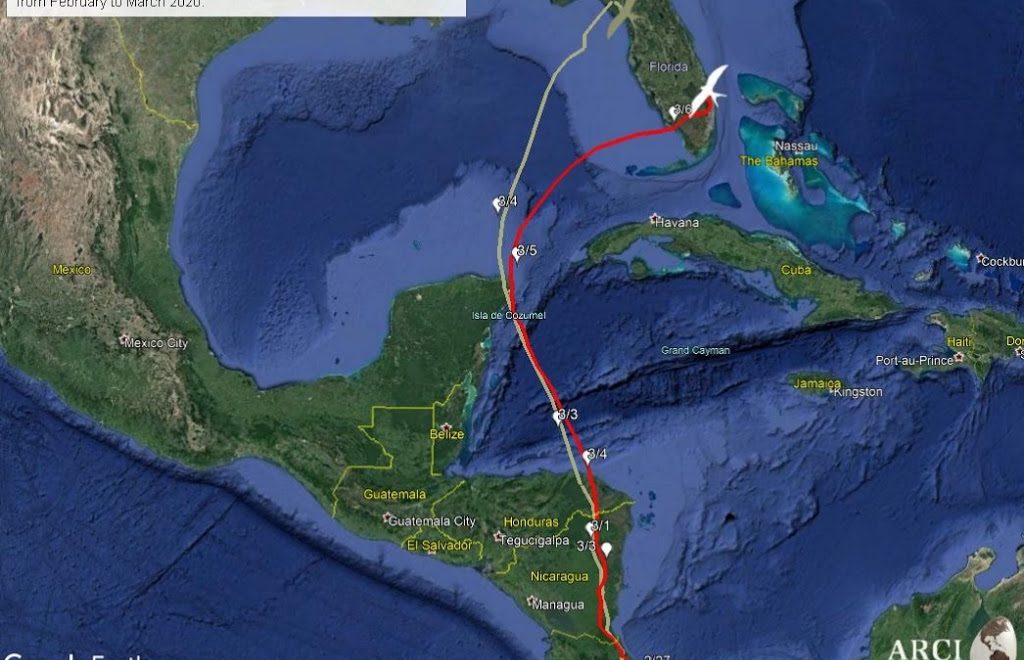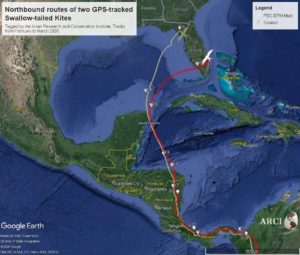As our GPS-tracked Swallow-tailed Kites are completing the last and most dangerous stage of their return to their United States nesting areas, we will be sharing their migration progress with you here. Each individual kite writes a new, unique story each year as it faces extraordinary, unpredictable risks unlike those they must overcome in any other season. Migration is very difficult and dangerous for any bird, but it is especially so for those that must cross large bodies of water, something that very few raptors ever attempt even over very short distances of just a few miles.
In our previous post, we shared Sanibel’s migration story (gray). Now, we would like to show you how the male Swallow-tailed Kite PBC-ERM accomplished the same dangerous mission just a few days later by taking a route that was, with some very impressive-but-frightening
Sanibel wintered 525 miles south of PBC-ERM and started north 8 days earlier, on 18 January, 2020. On his way north, Sanibel passed right through PBC-ERM’s wintering area. Soon, they were within 50 miles and 3 days of each other as they glided northward, a time-space relationship they maintained all the way to Mexico.
Tailwinds apparently encouraged both kites to make an otherwise unusual and very risky over-water crossing from the northern coast of Honduras to the city of Cancun, on the northeastern tip of Mexico’s Yucatan Peninsula. The difference was that, after flying 10 hours, Sanibel stopped for the night, whereas PBC-ERM skirted Cancun and embarked on a nonstop over-water flight to Florida. His daring passage spanned 930 miles of open ocean without rest, food, or water, a trip he completed in just 38 hours at an average ground speed of 25 miles per hour! Most northbound Swallow-tailed Kites cross no more than about 600 miles of the Gulf of Mexico from the Yucatan to the panhandle of Florida, which is already an amazing feat for any raptor.
Early on the morning of March 6th, PBC-ERM reached land within the Ten Thousand Islands National Wildlife Refuge of Collier County, Florida. He rested there for 5 hours, waiting for the day’s thermals to begin forming so that he could use their lift to continue his journey. Once aloft, he immediately headed east across peninsular Florida and soon reached his former Palm Beach County nest site.
As we noted in our previous post, Sanibel ended his rest on the northern Yucatan Peninsula on March 5th by catching a fast ride on strong southerly winds, crossing the Gulf of Mexico to the Big Bend region of northern Florida in just 24 hours. En route over the Gulf, he shot past Sanibel Island (at considerable distance). However, immediately after making land-fall, he turned southward along the shoreline towards his familiar Sanibel breeding grounds.
We are waiting for the next data upload and hoping it will show that Sanibel has settled back into his nesting neighborhood on Sanibel Island.
ARCI is grateful to the Palm Beach Zoo and Conservation Society and to the Palm Beach County Department of Environmental Resources Management for making it possible for ARCI to tag and track male Swallow-tailed Kite PBC-ERM. We also thank the Sanibel-Captiva Audubon Society, the family of the late Jim Griffith, the Sanibel-Captiva Conservation Foundation, and the Clinic for the Rehabilitation of Wildlife(CROW) for supporting the tagging and tracking of Sanibel.



Leave a Reply